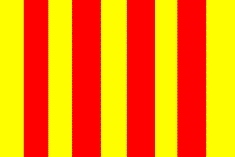The Departments of the Gard to the east, the Aveyron to the North, the Aude and the Pyrenees to the South West with the Mediterranean Sea form its boundary. The Department has two characteristic features - the coastal plain, flat and covered in vines and the mountainous north, famous for cherries and chestnuts. Since the 1960s, because of Government assistance, the Department has seen many changes along the coastal strip, but in many ways the interior has remained the same for the past two centuries
The climate has long been famous for its hot summers and mild winters, but equally well known are its winds. The Tramontane, blowing from the land, and the Marin blowing in off the sea. In summer the Tramontane brings clear blue skies and the warmth of the sun, whilst in the winter it brings the cold air from the North. The Marin is warm throughout the year but brings humidity and sea mist that can be dense on the coastal plain. The Department is a vast mixture of changes in landscape, from the golden sands of Valras, Agde, Palavas and La Grand Motte via the fertile plain to the Cevennes Mountains behind. The two extinct volcanoes of Agde and Sete are two obvious signs that this land has seen many geological changes that have made it one of the most interesting and varied areas in France. Continuing inland we find a mixture of Garrigue and vines, before arriving at the valleys and gorges of the Cevennes, with their many lakes, pine forests, and grazing land. The vines form an important part of the ecology, and can produce some surprising and interesting aspects to the eye, especially during the autumn when the leaves are changing colour. The golds and reds are spectacular. Amongst the vines you will see olive, peach and apricot trees. Olives were an important crop, with several oil mills in the area. There remain just two, one in Clermont l’Herault, and the other in Bize. Planting fruit trees was a practical thing to do. It not only provided fruit for the family, but also provided shade for the vignerons during his labours under the sun. Stretching along the coast like a string of pearls are the salt-water lakes known as etangs. These lakes were formed by silt being washed down the Rhone, and then deposited along the Languedoc coast by the tide. These lakes have formed their own economy in fishing and tourism. To the southwest lie the Corbiere hills that connect the Pyrenees through the Montagne Noire and the Monts de l’Espinouse to the Cevennes, thus forming a semi circle separating the Atlantic from the Mediterranean climate. The Corbieres are lushly vegetated limestone hills with deep gorges and large areas of vines, that produce some very good red wines




